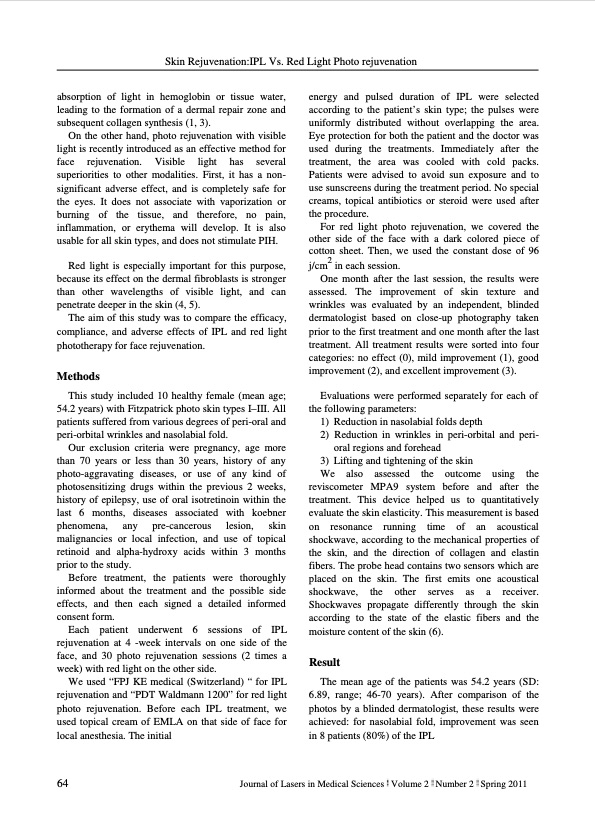
PDF Publication Title:
Text from PDF Page: 003
Skin Rejuvenation:IPL Vs. Red Light Photo rejuvenation absorption of light in hemoglobin or tissue water, leading to the formation of a dermal repair zone and subsequent collagen synthesis (1, 3). On the other hand, photo rejuvenation with visible light is recently introduced as an effective method for face rejuvenation. Visible light has several superiorities to other modalities. First, it has a non- significant adverse effect, and is completely safe for the eyes. It does not associate with vaporization or burning of the tissue, and therefore, no pain, inflammation, or erythema will develop. It is also usable for all skin types, and does not stimulate PIH. Red light is especially important for this purpose, because its effect on the dermal fibroblasts is stronger than other wavelengths of visible light, and can penetrate deeper in the skin (4, 5). The aim of this study was to compare the efficacy, compliance, and adverse effects of IPL and red light phototherapy for face rejuvenation. Methods This study included 10 healthy female (mean age; 54.2 years) with Fitzpatrick photo skin types I–III. All patients suffered from various degrees of peri-oral and peri-orbital wrinkles and nasolabial fold. Our exclusion criteria were pregnancy, age more than 70 years or less than 30 years, history of any photo-aggravating diseases, or use of any kind of photosensitizing drugs within the previous 2 weeks, history of epilepsy, use of oral isotretinoin within the last 6 months, diseases associated with koebner phenomena, any pre-cancerous lesion, skin malignancies or local infection, and use of topical retinoid and alpha-hydroxy acids within 3 months prior to the study. Before treatment, the patients were thoroughly informed about the treatment and the possible side effects, and then each signed a detailed informed consent form. Each patient underwent 6 sessions of IPL rejuvenation at 4 -week intervals on one side of the face, and 30 photo rejuvenation sessions (2 times a week) with red light on the other side. We used “FPJ KE medical (Switzerland) “ for IPL rejuvenation and “PDT Waldmann 1200” for red light photo rejuvenation. Before each IPL treatment, we used topical cream of EMLA on that side of face for local anesthesia. The initial energy and pulsed duration of IPL were selected according to the patient’s skin type; the pulses were uniformly distributed without overlapping the area. Eye protection for both the patient and the doctor was used during the treatments. Immediately after the treatment, the area was cooled with cold packs. Patients were advised to avoid sun exposure and to use sunscreens during the treatment period. No special creams, topical antibiotics or steroid were used after the procedure. For red light photo rejuvenation, we covered the other side of the face with a dark colored piece of cotton sheet. Then, we used the constant dose of 96 j/cm2 in each session. One month after the last session, the results were assessed. The improvement of skin texture and wrinkles was evaluated by an independent, blinded dermatologist based on close-up photography taken prior to the first treatment and one month after the last treatment. All treatment results were sorted into four categories: no effect (0), mild improvement (1), good improvement (2), and excellent improvement (3). Evaluations were performed separately for each of the following parameters: 1) Reduction in nasolabial folds depth 2) Reduction in wrinkles in peri-orbital and peri- oral regions and forehead 3) Lifting and tightening of the skin We also assessed the outcome using the reviscometer MPA9 system before and after the treatment. This device helped us to quantitatively evaluate the skin elasticity. This measurement is based on resonance running time of an acoustical shockwave, according to the mechanical properties of the skin, and the direction of collagen and elastin fibers. The probe head contains two sensors which are placed on the skin. The first emits one acoustical shockwave, the other serves as a receiver. Shockwaves propagate differently through the skin according to the state of the elastic fibers and the moisture content of the skin (6). Result The mean age of the patients was 54.2 years (SD: 6.89, range; 46-70 years). After comparison of the photos by a blinded dermatologist, these results were achieved: for nasolabial fold, improvement was seen in 8 patients (80%) of the IPL 64 Journal of Lasers in Medical Sciences Volume 2 Number 2 Spring 2011PDF Image | Pulsed Light Red Light Photo Rejuvenation for Skin Rejuvenation

PDF Search Title:
Pulsed Light Red Light Photo Rejuvenation for Skin RejuvenationOriginal File Name Searched:
Intense_Pulsed_Light_and_Red_Light_Photo_Rejuvenat.pdfDIY PDF Search: Google It | Yahoo | Bing
Cruise Ship Reviews | Luxury Resort | Jet | Yacht | and Travel Tech More Info
Cruising Review Topics and Articles More Info
Software based on Filemaker for the travel industry More Info
The Burgenstock Resort: Reviews on CruisingReview website... More Info
Resort Reviews: World Class resorts... More Info
The Riffelalp Resort: Reviews on CruisingReview website... More Info
| CONTACT TEL: 608-238-6001 Email: greg@cruisingreview.com | RSS | AMP |